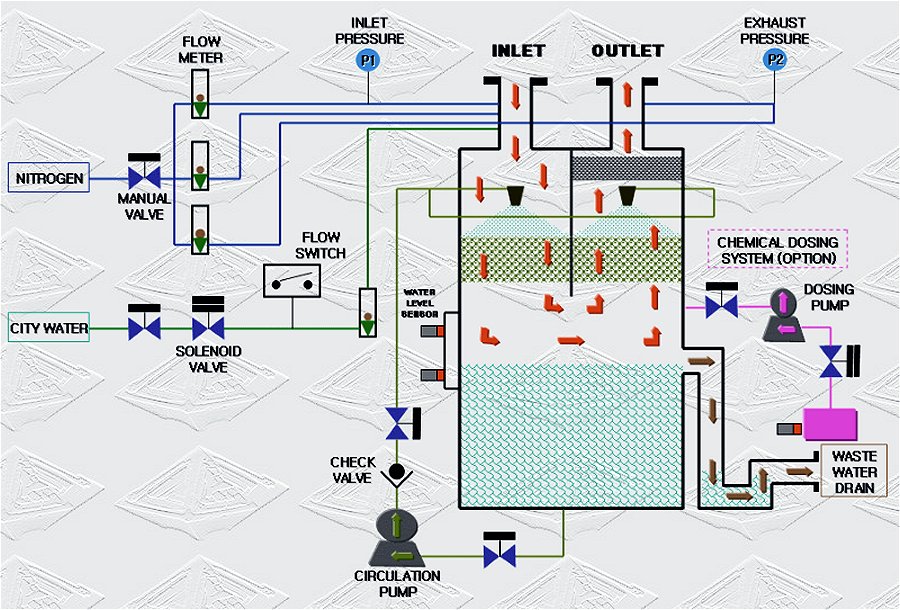MAIN MENU | home
Wet Exhaust Gas Cleaning (Explained)
Wet Exhaust Gas Cleaning
A wet scrubber is a simple method to clean exhaust air or exhaust gas and remove toxic or smelling compounds. In the flue gas scrubber, the gas gets in close contact with fine water drops in a co-current or counter current flow. This method is more effective when the water drop size gets smaller and the total surface between water or washing fluid and the gas gets larger. The water or washing fluid is recirculated normally in order to save water and reduce the amount of waste water.
 The following components can be removed from the exhaust gas:
Water soluble substances will be dissolved.
Dust will be precipitated.
Chemicals that can be hydrolised are decomposed.
Steam will be condensed.
The result is decontamination, detoxification, dedusting or dust removal, dehumidification, as well as removal of smelling for the benefit of our environment.
Especially water soluble components can be removed very well from the gas. By dissolving those components, the water or washing liquid will be contaminated in many cases. The dissolved components are frequently acid or basic chemicals like hydogen chloride HCl, nitric / nitrogen oxide NO / NO2 or ammonia NH3. By an optional neutralization unit, installed in the wet scrubber it is possible to keep the pH value of the washing liquid and the waste water at a neutral level. Furthermore absorption of acid components is improved by using basic washing liquid and removal of basic chemicals is more effective by using acid washing liquid.
Dust is precipitated and if larger amounts are created then this will lead to slurry accumulation in the waste water, which has to be removed by filtering. The filter cake might be special waste and has to be treated accordingly.
Compounds which hydrolyze decompose in contact with water. During the chemical reaction new soluble compounds might be created which are then removed immediately by the spray water. Solid reaction products might end up in the waste water as slurry and have to be filtered out and disposed. In the semiconductor industry wet scrubber are used e.g. for the removal of TEOS (Tetraethoxysilane), TiCl4 Titan tetrachloride or HMDSO (Hexamethyldisiloxane) from the exhaust gas.
A wet scrubber can be combined also with other flue gas cleaning methods. Gases can be first cleaned by a washer, then treated by a thermal reactor and then treated again by a wet scrubber. You can find such combined exhaust gas cleaners in our SBW and SWB gas scrubber.
SemiAn scrubber for process gas cleaning
SemiAn offers gas scrubber which have been developed for cleaning exhaust gas from single process tools, as they are used in the semiconductor and LCD industry. Therefore our gas cleaner are sized for a gas flow in the range of 100 - 1.200 slm or 6 - 72 m3/h. Of course, we can also offer gas scrubber of that size for other applications also. Our equipment is reliable and cost effective.
Gas extraction for etching bathes
A special application is the gas extraction and gas cleaning for acid or caustic etchers or etching bathes. Also solvent bathes which contain water soluble solvents like alcohols or aceton can be extracted. The exhaust air contains in this case rather low amounts of acid, lye or solvent. However the amount of extracted gas is rather high. SemiAn can offer scrubbers also for this application, e.g. the model SSW500.
Central Exhaust Gas Washer
For cleaning of large amounts of exhaust gas, industrial exhaust gas or collected exhaust gas from several process tools, usually large washer are installed beside the building or on top of the roof of a building. We can also offer such exchaust gas washers on request.
Source : Crystec Technology Trading GmbH
|